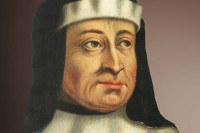Accursius seemed to have wished, with his Magna glossa (a systematic collection of 97,000 annotations on the Corpus Iuris Civilis), to sum up the efforts School of Glossators that had been working in Bologna on the interpretation of the Justinian’s compilation of Roman law since the founding of the university. After his generation, in fact, came the School of Commentators, and a new chapter of the analysis and circulation of Roman law began.
 Born in the Province of Florence in the early 1180s to a successful farming family, Accursius moved to Bologna in 1218.
Born in the Province of Florence in the early 1180s to a successful farming family, Accursius moved to Bologna in 1218.
In 1220, he began teaching Roman law, alongside the renowned Azzone, immediately winning fame, power and even citizenship (although he continued to sign himself as Florentine).
Contact with the older jurist allowed him to develop an innovative approach to the cardinal text of legal education and practice: the Corpus Iuris Civilis.
Studied philologically for the first time in Bologna by Irnerius, Pepo and the first professors at the University of Bologna, the Justinian legal text was recovered from the silence of the early Middle Ages and returned to being widely known and used by the new European jurisdiction.
The University of Bologna was specialised in the interpretation of the Latin volume as home to the famed School of Glossators, which had enriched the first manuscript editions with explanations, references and annotations called glosses.
This created an excess of notes that obstructed a uniform reading of the ancient Corpus.
During the first half of the 13th century, convenient summaries began to be written in Bologna (by Azzone, Iacopo di Balduino, Odofredo Denari), on the model of the ones drafted by Provençal jurists at the beginning of the century.
Accursius went further, sifting through an enormous quantity of glosses and gathering 97,000 of them into a single, clear and exhaustive Magna glossa that could be used both for teaching and for judicial procedures.
This immense summary was considered in the centuries that followed to be the official interpretation of the Corpus Iuris Civilis.
Accursius’s fame and power grew such that he was able to build a grand home for himself on the new city square (Piazza Maggiore), which was later purchased by the government to be transformed into a vast food warehouse (Palazzo della Biada) and then expanded and transformed into the immense Palazzo del Comune, still known today as Palazzo d’Accursio.
The wealthy jurist passed down his teachings and his career to his sons, who were not, however, able to equal him, in part because the practice of creating glosses had been replaced by the nascent School of Commentators.
Francesco, Cervotto and Guglielmo pursued legal careers, while Corsino became a notary.
He is also said to have had a daughter, Accursia, who became a teacher. This has never been confirmed by reliable sources, but it does reflect the fact that women were always a presence among the faculty at the University of Bologna during the Middle Ages.
Accursius and his son Francesco are buried in a tomb behind the apse of the basilica of San Francesco. The monument was commissioned by Francesco, who had his father’s body translated there from the monastery of San Domenico, where it had been temporarily buried.
